The figure shows a solid metal object moving through a uniform magnetic field given by B→ = (2.00×10−2 T)k^. The motion creates a potential difference of 1.30×10−3 V across the object, with the (unseen) left face negatively charged. What is the speed (m/s) of the object? B = 2.00×10−2 T, d1 = 5.00×10−2 m, d2 = 3.00×10−2 m, d3 = 2.00×10−2 m. 4.00 6.00 2.17 8.50 1.30 0.619 2.40 0.929 0.371 3.25
